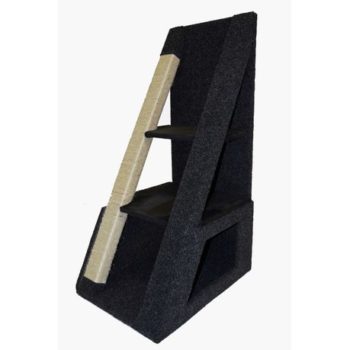It’s no secret that cats rule the roost in many households – raise your hand if you’ve given in to your cat’s 2am wake-up call for a chin scratch! – but succumbing to the charm of those pleading Puss-in-Boots eyes when it comes to food could put your beloved pet’s health at risk. Overweight cats are four times more likely to develop diabetes (which may require daily medication or even insulin injections), and are two and half times more likely to develop urinary stones that may require surgery, notes Dr Guy Fyvie, nutritional advisor at Hill’s Pet Nutrition.
ALSO SEE: 17 Awesome Facts About Cats That You Didn’t Expect
It’s time to take action when kitty’s bulging silhouette makes the cat flap redundant! However, if you’re not 100% sure that your moggy’s weight is an issue, use an online weight calculator as a starting point (we like the Hill’s Pet Nutrition calculator), though it’s best to consult your vet before deciding to change their diet. Your vet will rule out underlying health conditions that could be causing your cat’s weight gain, before offering diet guidelines. If you need more hands-on help controlling your cat’s waistline, consider a special weight-management programme, like Hill’s Pet Slimmer (find participating clinics, nationwide, at petslimmer.co.za).
ALSO SEE: 5 Essential Natural Pet Care Books You Need
Dr Fyvie offers five tips to help bring your cat back from the brink of Garfield-dom!
1. Less food vs better food choices
Simply cutting back on the amount of food you give your overweight cat isn’t the solution – instead of restricting kilojoules, chat to your vet about choosing a food that increases your cat’s metabolism.
2. Introducing new food
Don’t suddenly change your cat’s food, as it could upset their tummy, or they may just point blank refuse to eat it! The key is introducing new food gradually. Over a week, mix your cat’s current food with the new food, starting at a ratio of 75% old food: 25% new food. Slowly shift that ratio until you’re at 100% of the new food.
3. How much food
The correct amount of food you should be feeding your cat, as per the guide on the food’s packaging, should be calculated for your cat’s ideal weight, not their current weight. Consult your vet about your cat’s ideal weight goal.
4. When only one of your two cats is overweight
If you have two cats, and only one is on a diet, it’s a good idea to restrict your overweight cat’s access to both bowls of food. You could place your thinner cat’s food bowl on a higher level – the effort to reach this will put off your overweight cat. You could also cut a hole in a cardboard box that’s only big enough for the smaller cat to get through – place that cat’s food inside the box where the overweight cat can’t reach it.
ALSO SEE: 13 Foods That Are Poisonous For Your Pet
5. Get them moving
Exercise is crucial for all cats, not just those who are overweight – but if your overweight cat is lazy, you’ll have to initiate play to encourage movement. There are loads of toys that encourage active play, available at vets and pet shops, but something as simple as a scrunched-up piece of paper will work. A wand or cat tickler will encourage hunting, running and jumping, as will a tall scratch post. Takealot.com stocks a wide selection of scratch posts by various brands, starting from around R250 for a small post – we like The Wedge Scratching Post by Scratzme, R1 538, because it’s tall enough at 1m to encourage real play and sturdy enough to hold the weight of a big cat.

Compiled by Managing Editor Stacey Love

